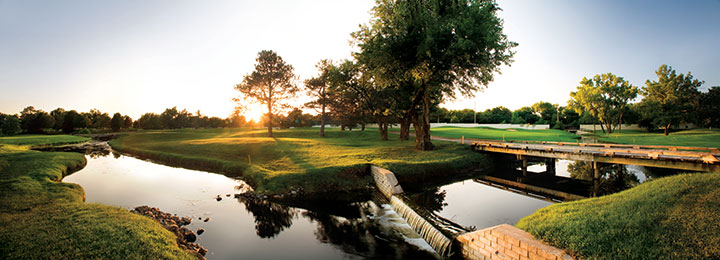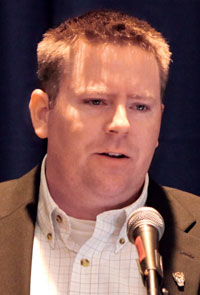Plant Health Part 3: Top tips for surviving summer
These tips from four industry experts can help superintendents beat the heat.

No. 2 at Wichita CC
Creeping bentgrass (Agrostis stolonifera) and annual bluegrass (Poa annua) putting greens experience some degree of heat stress nearly every summer. The amount of damage from heat stress varies each year because of the intensity and duration of hot weather. The damage can range from off-color turf to thinning of the turf to large areas of dead turf.
The first symptoms of heat stress usually appear in combination with another stress, most commonly traffic stress. The first symptoms of combined heat and traffic stress are poor tolerance to golfer traffic around the cup and at points where traffic is confined to a single entry or exit point off the green. The effects of these stresses also show up as loss of turf density in the cleanup mower pass.
The underlying reason for turfgrass decline from heat stress in creeping bentgrass and annual bluegrass is the imbalance of photosynthesis and respiration. During summer when air temperatures are above 80 degrees, turfgrass plants consume more carbohydrates (energy) through respiration than they produce through photosynthesis. The higher the air temperature is above 80 degrees and the longer per day it remains above 80, the greater the degree of heat stress the turfgrass plant must endure.
Coping mechanisms to deal with heat stress include managing traffic patterns on greens, raising mowing heights, skipping mowing one or two days a week, alternating days of mowing and rolling, providing adequate water but not overwatering, providing sufficient nutrients and following a comprehensive preventive fungicide program to manage diseases.
While all these suggestions are sound agronomic practices and when properly implemented reduce damage from heat stress, superintendents and scientists use other techniques to help turfgrass survive the heat of summer. What follows are the tips and insights of four experts who nurse creeping bentgrass and annual bluegrass greens through long, hot summers year in and year out.
Erik Ervin, Ph.D., Virginia Tech

Make sure there is ample air in the pore spaces in the upper 2 inches of the rootzone, according to Erik Ervin, Ph.D., turfgrass scientist at Virginia Tech University.
“Air is less dense than water and therefore holds less heat than water,” Ervin says. “Maintaining air in the pore spaces in the upper portion of the rootzone will keep the rootzone cooler, helping the grass survive heat stress.” He adds that venting aerification with solid tines approximately ¼ inch diameter on 2-by-2 inch spacing to a depth of 3 or 4 inches every 2 or 3 weeks, weather permitting, is a big help in maintaining air in the pore space in the rootzone and thus improving drainage.
Avoiding wet — or even worse, saturated conditions in the upper portion of the rootzone improves turf performance during heat stress. Using a time domain reflectometry (TDR) instrument to measure soil moisture and continually monitor it helps superintendents achieve the proper balance of air and water in the upper 2 inches of the rootzone, Ervin says.
He adds that the routine use of soil surfactants helps to uniformly distribute water in the rootzone and move it more efficiently through the rootzone. Consider using fans to moderate temperature and dry out the rootzone. He also suggests avoiding or reducing the use of DMI fungicides, Cutless (flurprimidol) and Trimmit (paclobutrazol) on annual bluegrass because it can be sensitive to these products, particularly during periods of heat stress.
Jim Kerns, Ph.D., N.C. State
 The diagnostic lab at North Carolina State University is busiest during hot, dry summers, according to Jim Kerns, Ph.D., turfgrass pathologist at N.C. State. That’s because a greater range of problems occur during hot, dry weather. These problems include heat, drought and traffic stresses along with nematodes and diseases, as opposed to primarily disease problems during hot, wet summers.
The diagnostic lab at North Carolina State University is busiest during hot, dry summers, according to Jim Kerns, Ph.D., turfgrass pathologist at N.C. State. That’s because a greater range of problems occur during hot, dry weather. These problems include heat, drought and traffic stresses along with nematodes and diseases, as opposed to primarily disease problems during hot, wet summers.
Kerns recommends submitting a turfgrass sample for diagnosis at the first sign of a problem. “Most people wait too long to submit a sample for diagnosis, and by the time we determine the problem it is often too late for the corrective measures to be effective,” he says.
He also suggests following a fungicide application program every 2 weeks, tank mixing a contact and systemic fungicide or a tank mix of a contact fungicide and a phosphite product. For contact fungicides he suggests mancozeb, chlorothalonil or fluazinam. Like Ervin, he supports avoiding the use of DMI fungicides during hot weather.
Other cultural practices should include spoon feeding with nitrogen, he emphasizes, because, “low nitrogen fertility leads to more problems.” Also continue to needle-tine aerify and topdress unless temperatures are extremely high.
And while not mowing one day a week or on alternating days or mowing with rolling are well-known steps to reduce the impact of heat stress while maintaining acceptable putting green speed, Kerns notes that many superintendents are reluctant to implement these practices.
Jeff Sexton, Evansville Country Club
Keeping the rootzone on the dry side tops the list of tips from Jeff Sexton, superintendent at Evansville (Ind.) Country Club. Located on the Ohio River, Evansville’s summers are hot, humid and long. To achieve his goal of a rootzone with adequate, not excessive, soil moisture, Sexton and his staff primarily hand water greens during hot weather, focusing on the collars and outside portion of the green and syringing two or three times a day during hot weather.
Sexton uses a soil moisture meter every day on all 18 greens. Through routine monitoring and experience he has determined a threshold at which he needs to irrigate greens using the irrigation system. Sexton believes he has reduced the amount of water applied to the greens “by about 25 percent” by using the soil moisture meter.
Sexton manages 13 greens with a sand-based rootzone and seven greens with a soil-based rootzone. He’s found that regular applications of wetting agents move water through both rootzones more effectively, helping achieve his goal of having adequate water in the rootzone.
When air temperatures reach the mid-90s, Sexton starts to “play defense,” focusing on the survival of the grass. During these periods of extremely high temperatures he alternates days of mowing and rolling greens. His play-defense strategy has been helped by a slight increase in mowing height the last couple of years. While continuing to “play defense,” Sexton aerifies with 3/8-inch solid tines twice a month and topdresses lightly each week except during long periods of extremely hot weather.
Brian White, Wichita Country Club
 For Brian White, superintendent at Wichita (Kan.) Country Club, helping his 65-year-old creeping bentgrass/Poa annua greens through a tough Kansas summer begins with sound water management. He and his staff monitor soil moisture every morning using a soil moisture meter, focusing their attention on both wet and dry areas. They hand water only those areas requiring water. With the exception of using the irrigation heads to water in products applied to the greens, White relies on hand watering during the summer.
For Brian White, superintendent at Wichita (Kan.) Country Club, helping his 65-year-old creeping bentgrass/Poa annua greens through a tough Kansas summer begins with sound water management. He and his staff monitor soil moisture every morning using a soil moisture meter, focusing their attention on both wet and dry areas. They hand water only those areas requiring water. With the exception of using the irrigation heads to water in products applied to the greens, White relies on hand watering during the summer.
To take advantage of the Kansas wind, of which there is plenty, White and his staff have opened corridors in the trees surrounding the putting greens to provide good air movement across the green surfaces. In addition, White applies wetting agents on a regular schedule to move water more effectively into and through the rootzone.
“Everything in moderation” is White’s guiding principle on other management practices during periods of heat stress. He spoonfeeds nutrients, applies Primo (trinexapac-ethyl), vents greens every 2 to 3 weeks and topdresses lightly every week during summer, but keeps a close eye on the forecast and adjusts when extremely hot weather occurs.
“Be observant” is another principle White follows and imparts to his staff. They spend time on each green every morning and afternoon. “It is amazing how fast a green can get away from you if you aren’t out there every day looking at it,” he notes.
With superintendents facing the prospect of a long, hot summer, these golf course experts hope a few of these strategies and tips can help greens beat the heat.
Clark Throssell, Ph.D., is a turfgrass scientist and research editor for Golfdom. He provides research and educational expertise to the golf industry. He helps solve agronomic problems and teaches seminars to golf industry professionals. Throssell can be reached at clarkthrossell@bresnan.net for more information.
Photo by: Paul Chauncy









